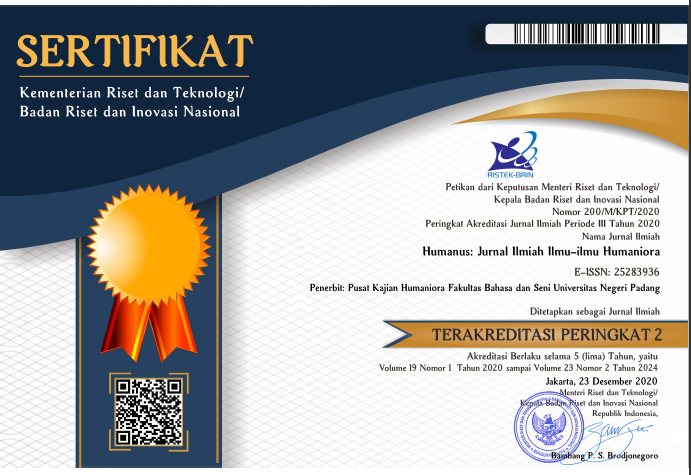Lower Class Representation in the Film Shoplifters
 ), Tia Saraswati(2),
), Tia Saraswati(2), (1) Universitas Gadjah Mada
(2) Universitas Airlangga
 Corresponding Author
Corresponding Author
Copyright (c) 2022 Humanus
DOI : https://doi.org/10.24036/humanus.v21i2.116350
Full Text:
 Language : en
Language : en
Abstract
This paper discusses the representation of the lower class and social reality in Japan through the film Shoplifters. This film is analyzed using the representation theory of Stuart Hall, with critical discourse analysis. The characters in the film are members of a marginalized social class who voice problems of poverty, stigmatization, family problems, and social alienation that on the other hand, are clashed with humanism values. The result of this study indicate that Shoplifters is a social critique that represent the lower class in Japan. The humanistic side shown by the characters through their attitude and dialogue becomes a paradox, as an effort to fight the stigmatization of the lower class that has taken root due to sociohistorical factors. Japan's advancement has impact on the alienation which they tried to overcome by building social cohesion in the form of a family.
Keywords
References
Brasor, P. & Tsubuku, M. (2018). Poverty in Japan: Underclass struggles to achieve upward mobility. Retrieved from https://www.japantimes.co.jp/news/2018/07/13/business/poverty-japan-underclass-struggles-achieve-upward-mobility/
Desapriya, E.B.R & Nobutada, I. (2002). Stigma of Mental Illness in Japan. The Lancet Vol. 359, May, 25 2002.
Devi, R. (2015). Struktur Keluarga Jepang dan Implementasinya dalam Keluarga Indonesia. In R. Nurfaidah (Ed.), Sastra Kita: Kini, Dulu, dan Nanti (p. 513-520). Jatinangor: Unpad Press.
Fatimah, B. N. (2019). Mekanisme pertahanan ego tokoh Nobuyo Shibata dalam film Manbiki Kazoku (Shoplifters) karya Hirokazu Kore-Eda. Jakarta: Universitas Indonesia (Undergraduate thesis).
Fihadiena, K. (2020). Analisis Konflik Batin Shota Shibata dalam Film Manbiki Kazoku. Purwokerto: Universitas Jenderal Soedirman (Undergraduate thesis).
Hashimoto, K. (2000). Class Structure in Contemporary Japan. International Journal of Sociology, Spring, 2000, Vol. 30, No. 1, pp. 37-64.
Ihsani, F. (2020). Gambaran Kemiskinan di Jepang dalam Film Shoplifters. Jakarta: Universitas Indonesia (Undergraduate thesis).
Iwabuchi, K. (2021). Cool Japan, Creative Industries, and Diversity. ERIA Discussion paper series No. 287. Retrieved from https://www.eria.org/uploads/media/ERIA_DP_no.287.pdf
Japan Today. (2012). 'Kizuna' takes many forms in post-disaster Japan, including marriage and infidelity. Retrieved from https://japantoday.com/category/features/kuchikomi/kizuna-takes-many-forms-in-post-disaster-japan-including-marriage-and-infidelity
Jhally, S. (1997). Representation and the Media (transcript). Media Education Foundation.
Kaufman, S.M. (2018). Hirokazu Koreeda: ‘I want to make visible the people the government ignores’. Retrieved from https://lwlies.com/interviews/hirokazu-koreeda-shopliters/
Kemdikbud. (2016). Kamus Besar Bahasa Indonesia. Jakarta: Badan Pengembangan dan Pembinaan Bahasa.
Margolis, E. (2020). Why Parasite’s success is forcing a reckoning in Japan’s film industry. Retrieved from https://www.vox.com/world/2020/3/3/21158315/parasite-oscar-south-korea-japan-film-bong-joon-ho
Matsuura, K. (2005). Kamus Jepang-Indonesia. Jakarta: Gramedia Pustaka Utama.
Miller, S. (1990). Foucault on Discourse and Power. Theoria: A Journal of Social and Political Theory(76), 115-125.
Nakagawa, S. (2018). 'Anti-Japan' criticism hits film director, researchers who keep gov't at arm's length. Retrieved from https://mainichi.jp/english/articles/20180730/p2a/00m/0na/008000c
Nakamura, T. (2013). Japan’s New Public Diplomacy: Coolness in Foreign Policy Objectives. Nagoya: Media and Society (メディアと社会) Graduate School of Languages and Cultures, Nagoya University.
Naito,T., and Gielen, U. (1992). Tatemae and Honne: A Study of moral relativism in Japanese culture. Psychology in international perspective, p. 161-172. Amsterdam: Swets and Zeitlinger.
Nishi, D., Ishikawa, H., & Kawakami, N. (2019). Prevalence of mental disorders and mental health service use in Japan. Psychiatry and Clinical Neurosciences 73: 458–465, 2019.
Noviani, R. (2020). Politik Representasi di Era Serbamedia. In W. Udasmoro (Ed.), Gerak Kuasa: Politik Wacana, Identitas, Ruang/Waktu dalam Bingkai Kajian Budaya dan Media (p. 59-84). Jakarta: Kepustakaan Populer Gramedia.
Pang, C., & Kurokawa, M. (2020). Viewing Kore-Eda's Nobody Knows and Shoplifters through Legal-Social Lenses. Asian-Pacific Law & Policy Journal, 21(2), 1-40.
Powell, J.L. (2015). Foucault, Power and Culture. International Journal of Humanities and Cultural Studies, 1,(4), 401-419
Roberts, G.S. (2016). Japan’s Evolving Family: Voices from Young Urban Adults Navigating Change. Honolulu: East-West-Center, University of Hawaii.
Sajarwa. (2021). Swear Words in French: Analysis of Social Class and Gender. Humanus, Vol. 20, No.2, 2021, p. 139-152. Padang: Pusat Kajian Humaniora, Fakultas Bahasa dan Seni, Universitas Negeri Padang.
Santos, T.D. (1970). The Concept of Social Classes. Science & Society, Summer, 1970, Vol. 34, No. 2 (Summer, 1970), pp. 166-193.
Sunda, M. (2015). Japan's Hidden Caste of Untouchables. Retrieved from https://www.bbc.com/news/world-asia-34615972
Touyama, S. & Poudyal, H. (2021). Prevalence of kodokushi (solitary deaths) in the Tokyo metropolitan area. Social Sciences Springer Nature Journal 1:163.
The Government of Japan. About Kizuna. Retrieved from https://www.japan.go.jp/kizuna/about_kizuna.html
Van Dijk, T. A. (1993). Principles of Critical Discourse Analysis. Discourse & Society. SAGE (London. Newbury Park and New Delhi), vol. 4(2): 249- 283.
 Article Metrics
Article Metrics
 Abstract Views : 1145 times
Abstract Views : 1145 times
 PDF Downloaded : 450 times
PDF Downloaded : 450 times
Refbacks
- There are currently no refbacks.
Copyright (c) 2022 Humanus

This work is licensed under a Creative Commons Attribution-NonCommercial 4.0 International License.










